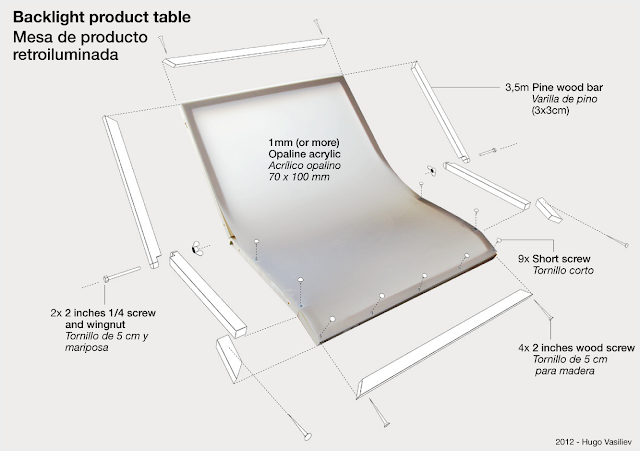
Les cuento sobre un accesorio que usé bastante en mis inicios con la fotografía macro, es un tubo adaptador para cámaras point and shot que no traen ese accesorio. La idea básica es adosar el adaptador al la fijación de trípode de la cámara para sostener un lente invertido, o sea con la optica frontal mirando hacia la cámara. De esta forma es muy rápido y fácil colocar el adaptador y disparar. Yo realmente lo usaba con el lente pegado con una vuelta de cinta adhesiva al tubo, pero luego conseguí los anillos adaptadores y lo mejoré un poco. La magnificación depende de la focal del lente, el mas usado es un normal de 45 o 50 mm pero también he usado un 28 y la amplificación es mayor.
I tell you about an accessory that I used a lot in my early days with macro photography, is a tube adapter for point and shot cameras that do not bring that accessory. The basic idea is to attach the adapter to the thread of the tripod of the camera to hold a lens reversed, the idea is that the front optic is facing the camera. This makes it very quick and easy to place the adapter and shoot. I actually used it with the lens attached with adhesive tape around the pipe, but then I got the adapter rings and I've improved a bit. The magnification depends on the focal length of the lens, the most used is a normal 45 or 50 mm but I used a 28 and the amplification is greater.
Uso / Use
La cámara hay que ponerla en foco manual y llevarla a la mínima distancia de enfoque y el zoom hay que llevarlo a la posición tele o un poco mas en la zona de ampliación digital para eliminar la viñeta. En mi cámara yo ajuste el tubo para que con el zoom extendido no toque el lente revertido. Pero para cada cámara tendrá una longitud que habrá que determinar haciendo algunas pruebas. Para hacer foco al fotografiar hay que acercarse al sujeto (con suavidad para que no escape) hasta ver por el visor que el foco está donde lo queremos y con un poco de suerte disparar. El uso de flash aumenta la tasa de éxito pero se puede usar sin el. Para usar el flash hay que poner un papel pegado al lente que reciba la luz del flash y actue como difusor. O un flash externo con sincronismo por fotocélula porque generalmente las point and shot no tienen conexion para flash externo. También se puede usar un iluminador led.
The camera must be set to manual focus to take the minimum focusing distance and zoom to tele position or a little more into the digital zoom. In my camera I set the tube to to the length that the extended zoom lens does not touch the reversed lens. But for each camera will have a length to be determined by tests. To focus when photographing must be set approaching the subject (gently so you do not escape) to see through the viewfinder that the focus is where you want, and with some luck shooting fine. Using flash increases the success rate but can be used without it. To use the flash you have to put a paper attached to the lens that receives light from the flash and act as a diffuser. Or an external flash sync photocell, because generally shot point and have no connection to external flash. You can also use an LED illuminator.
Construcción / construction
No pongo medidas porque no creo que nadie vaya a usarlo con una S70 pero el díametro del tubo de 50mm (2 inches) es ideal porque se aproxima al diametro de la rosca frontal del lente de 49 mm (filtro).
Para construirlo hice un dibujo en papel con las medidas y lo pegué al tubo, luego con una sierra hice los cortes. La aleta que apoya en la base de la cámara la aplasté con un martillo sobre una tabla hasta que quedó recta y luego con un poco de fuerza hay que centrar el tubo con el lente de la cámara. Hacer el agujero del tornillo de trípode con precisión y ya! El tornillo fue salvado de un pequeño trípode chino.
I do not put measures because I think anyone is going to use it with a S70 but the tube diameter of 50mm (2 inches) is ideal because it is close to the front thread diameter of 49 mm lens (filter).
To build it I did a drawing on paper and pasted it the measures to the tube, then with a saw I made the cuts. The flap that rests on the base of the camera was smashed with a hammer on a table until it was straight and then with some force you must center the tube with the camera lens. Make the tripod screw hole accurately and done! The screw was salvaged from a small Chinese tripod.
Test shoot










